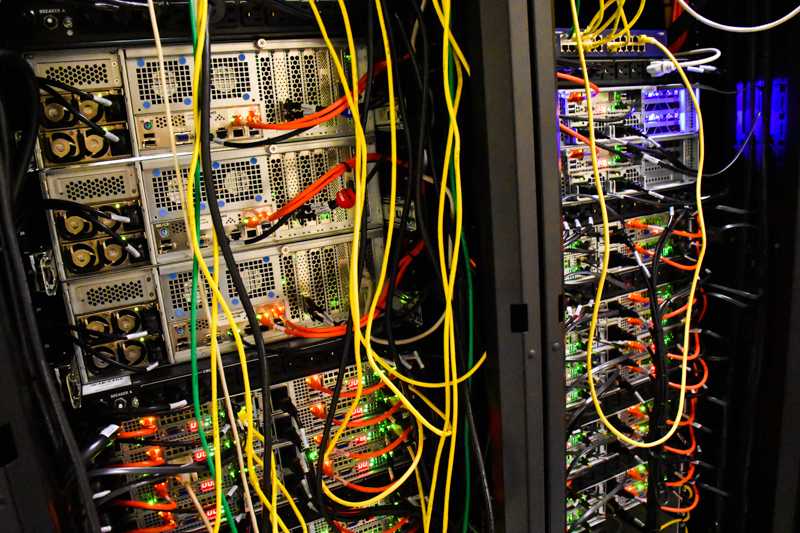New Supercomputer to Enhance Data Processing
An inside view of the College’s new supercomputer, SCIURus. The updated system replaced its 10-year-old predecessor last spring, and opened for use this month.
September 25, 2015
The College’s new supercomputer, SCIURus, is now open in the Science Center for student and faculty research, reasserting Oberlin as a leader in supercomputing capability among liberal arts colleges.
The College installed SCIURus in May 2015, replacing the Science Center’s previous supercomputer, Beowulf, from 2005. After a month of assembly and a summer of beta testing, the computer cluster, consisting of nearly 200 terabytes of storage and 36 processors, each with 256 gigabytes of random access memory, was ready for use this month.
According to Michael Moore, professor of Biology and chair of the High Performance Computing Committee, the new supercomputer is a huge upgrade.
“The entire old system is as good as one of our nodes,” Moore said. “It wouldn’t be incorrect to say that the new system is 36 times more powerful than the old one.”
The search for a new supercomputer began in 2013 when the HPC Committee — consisting of Moore, Professors of Chemistry Manish Mehta and Matthew Elrod, Professor of Biology Aaron Goldman and Professor of Physics and Astronomy Robert Owen — sent a grant proposal to the National Science Foundation.
Although the grant was initially denied, the team resubmitted a proposal in August 2014 and received a sum of $486,256 from the foundation to purchase the new high-performance computer cluster.
During the fall semester of 2014, the committee researched different supercomputer companies to get the best quote possible. Moore explained that each supercomputer is custom-built, so the committee needed to make sure that the companies that they were working with understood the College’s needs in a supercomputer based on the desired research of students and faculty. The committee contacted engineers from these companies and tried to find the most cost-effective design for the money. In January, they chose a company, and after three months of building, the supercomputer was brought to Oberlin.
Moore decided to name the new computer Sciurus, using the Latin name for Oberlin’s newly adopted mascot, the albino squirrel, which he turned into an acronym for SuperComputing in Undergraduate Research.
In addition to the faster processing and larger memory, Moore said that the supercomputer has a graphical processing unit, lacking in the old supercomputer. All of these advancements will allow a variety of professors and students on campus to utilize the supercomputer simultaneously.
Given its advantages, professors from Neuroscience, Biology, Physics, Chemistry and other departments have begun to look into utilizing the supercomputer for their research.
“For me, it’s an essential element of my work,” Owen said. “I do work on what happens when two black holes collide with each other. … If you want to study how one black hole interacts with another black hole you need to turn the math into an enormous algebra problem that needs to be solved by a computer.”
Moore uses the computer to study genomes and the evolutionary relationships among organisms by looking at large DNA sequence data. Mehta plans on using it with his student research team to examine models of co-crystals, an important concept in pharmaceutical development.
Mehta speculated about the learning benefits of having a supercomputer on campus, as previously large amounts of data had to be processed in supercomputers offsite in limited time slots.
“Students have the opportunity to learn. Research teams can make mistakes without a high price,” Mehta said. “It allows for students to learn high-performance computing in a local environment.”
According to Moore, in the coming weeks the committee is planning on holding an information session about how to use the supercomputer. The SCIURus website, which can only be accessed through the campus network, also has an application form online for Oberlin students and faculty to request to use SCIURus for research.


























